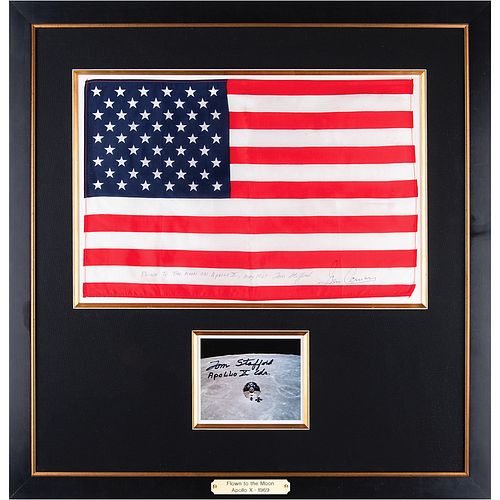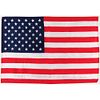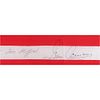Apollo 10 Flown Oversized American Flag - From the Collection of Tom Stafford
Two ways to bid:
- Leave a max absentee bid and the platform will bid on your behalf up to your maximum bid during the live auction.
- Bid live during the auction and your bids will be submitted real-time to the auctioneer.
Bid Increments
| Price | Bid Increment |
|---|---|
| $0 | $5 |
| $50 | $10 |
| $200 | $25 |
| $500 | $50 |
About Auction
Apr 25, 2024
Featuring nearly 400 items, RR's Spring Space Exploration auction is filled with flown material, astronaut autographs, Apollo hardware, and other space rarities. RR Auction support@rrauction.com
- Lot Description
Immense flown American flag carried into lunar orbit during the Apollo 10 mission, 18.5″ x 11.5″, signed and flight-certified in black ballpoint, “Flown to the moon on Apollo X, May 1969, Tom Stafford,” and in black ink, “Gene Cernan.” Archivally matted and framed with a Stafford-signed lunar photo to an overall size of 26.5 x 26.5. In fine condition.
Accompanied by a detailed letter of provenance signed “Thomas P. Stafford,” written on his personal stationery, which reads: “The accompanying Apollo X United States Flag was carried by me aboard the Command Module ‘Charlie Brown’ in orbit around the Moon. This United States Flag made of Nylon and measures 12 inches by 18 inches was carried by me to the Moon in May of 1969 as part of my personal preference kit (PPK) and later signed by both me and Gene Cernan. The Apollo X (10) spacecraft was launched from Cape Kennedy at 12:49 p.m. on May 18, 1969. This mission was the first flight of lunar module (LM-4) to the Moon. After the spacecraft completed one and a half revolutions of the Earth, the S-IVB 3rd stage booster was reignited to increase the speed of the spacecraft to the velocity required to escape the gravitational attraction of the Earth. Three days later, the spacecraft was placed in orbit around the Moon.
Nineteen color television transmissions (totaling 5 hours 52 minutes) of remarkable quality provided the world audience with the 1st color television in space and the best exposure yet to spacecraft activities and spectacular views of the earth and the moon.
Gene Cernan and I descended in the lunar module to an altitude of less than 47,000 feet above the Moon. At this altitude, we were able to reconnoiter the proposed Apollo 11 landing site. The LM then completed the 1st successful rendezvous in lunar orbit with John Young in the command module.
We began the return journey to Earth. During re-entry we reached a velocity of 24,791 mph which is still the record for the fastest that any human has ever traveled, making this flag one of the fastest objects carried by humans in space. Splashdown occurred at 12:52 p.m. on May 26, 1969, 1.3 nautical miles from the target landing point.
During the Apollo Program, it was NASA's policy to allow astronauts to keep personal items from their mission as personal mementos, and I accordingly chose to include this United States Flag among mine. This US Flag then remained a treasured part of my personal space collection from December 1972, when it was returned to me by NASA.”
A patriotic extension from one of the Apollo program's most significant missions, one deemed the 'dress rehearsal' for the Apollo 11 moon landing. This flag orbited the moon a total of 31 revolutions and traveled nearly 830,000 miles during its eight-day voyage before re-entering the Earth's atmosphere at a world-record speed of 24,791 mph, or Mach 36—making it the fastest large U.S. flag ever flown. An incredible Apollo-era artifact made all the more desirable for its rock-solid provenance and atypically large size. - Shipping Info
-
Bidder is liable for shipping and handling and providing accurate information as to shipping or delivery locations and arranging for such. RR Auction is unable to combine purchases from other auctions or affiliates into one package for shipping purposes. Lots won will be shipped in a commercially reasonable time after payment in good funds for the merchandise and the shipping fees are received or credit extended, except when third-party shipment occurs. Bidder agrees that service and handling charges related to shipping items which are not pre-paid may be charged to a credit card on file with RR Auction. Successful international Bidders shall provide written shipping instructions, including specified Customs declarations, to RR Auction for any lots to be delivered outside of the United States. NOTE: Declaration value shall be the item’(s) hammer price and RR Auction shall use the correct harmonized code for the lot. Domestic Bidders on lots designated for third-party shipment must designate the common carrier, accept risk of loss, and prepay shipping costs.
-
- Buyer's Premium



 EUR
EUR CAD
CAD AUD
AUD GBP
GBP MXN
MXN HKD
HKD CNY
CNY MYR
MYR SEK
SEK SGD
SGD CHF
CHF THB
THB







